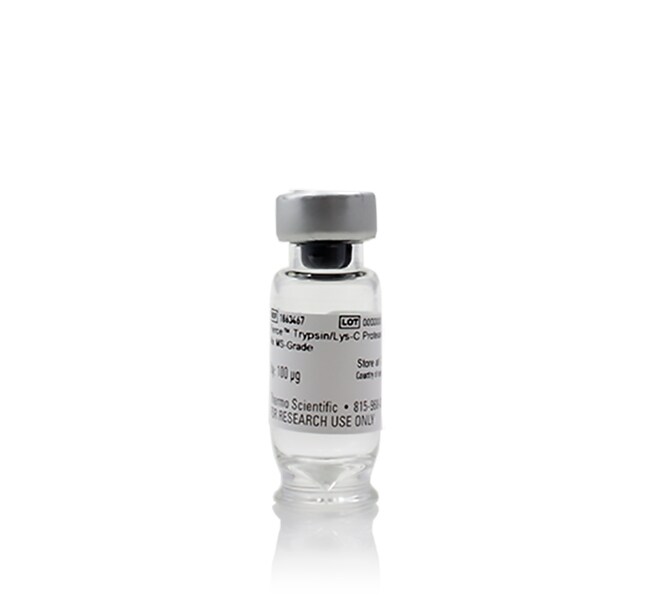Search Thermo Fisher Scientific

Mezcla de proteasas tripsina/Lys-C Pierce™, grado MS
| Número de catálogo | Cantidad | Tipo de producto |
|---|---|---|
| A41007 | 5 x 20 μg | Mezcla de proteasa de tripsina/Lys-C |
| 90053 | 2 μl | Proteasa |
| 90056 | 4 × 25 μl | Proteasa |
| 90054 | 5 × 10 μl | Proteasa |
| 90305 | 1 x 100 μg | Proteasa tripsina |
| 90059 | 1 mg | Proteasa tripsina |
| A40007 | 20 μg | Mezcla de proteasa de tripsina/Lys-C |
| A40009 | 100 μg | Mezcla de proteasa de tripsina/Lys-C |
| 90051 | 1 × 20 μl | Proteasa |
| 90307 | 100 μg | Proteasa |
| 90057 | 5 x 20 μg | Proteasa tripsina |
| 90058 | 5 x 100 μg | Proteasa tripsina |
Las características de la mezcla de proteasa tripsina/Lys-C Pierce, calidad MS, incluyen:
• Mejora de la digestión: la combinación de enzimas reduce las escisiones trípticas omitidas
• Cómodo: proteasas tripsina y LysC suministradas en una relación optimizada para la digestión en un formato de uso combinado
• Selectividad excepcional: la tripsina tiene > 95 % de especificidad de lisina y arginina de terminal C; LysC tiene > 90 % de especificidad de escisión de lisina de terminal C
• Estable: mezcla de enzimas suministrada en un formato liofilizado
La caracterización, identificación y cuantificación de proteínas por MS comienza con la digestión de proteínas eficiente y reproducible. Aunque la tripsina se utiliza habitualmente para la digestión de proteínas, esta proteasa por sí sola no es suficiente para digerir completamente proteínas en el extremo carboxilo de los residuos de lisina y arginina. Por tanto, la proteasa Lys-C se suele combinar con la tripsina para digerir secuencialmente proteínas con menos escisiones omitidas. La mezcla de proteasa tripsina/Lys-C Pierce es una mezcla liofilizada de proteasas tripsina y LysC que se ha optimizado para mejorar la eficacia de la digestión de proteínas. Se suministra en formatos flexibles de 20 µg, 5 x 20 µg o 100 µg, y también se incluye en el kit de preparación de muestras de MS EasyPep Mini.
La proteasa tripsina de calidad MS de esta mezcla se deriva de extractos pancreáticos porcinos y se ha tratado con TPCK para eliminar la actividad quimotríptica y metilada a fin de mejorar la estabilidad durante la digestión. La proteasa Lys-C de calidad MS es una enzima nativa altamente purificada de Lisobacter enzymogenes. A diferencia de la tripsina, Lys-C puede disociar lisinas seguidas por prolinas, por lo que resulta ideal para su uso en combinación con otras proteasas para una digestión óptima de las proteínas. Cuando se utiliza como mezcla, la digestión se puede completar en tan solo 1,5–3 horas o durante la noche, dependiendo de la relación enzima-proteína. Esta mezcla de enzimas liofilizadas es estable durante un año cuando se almacena a -20 °C.
Productos relacionados
Kit de preparación de muestras de MS EasyPep Mini
Ensayo de cuantificación de péptidos colorimétrico Pierce
Cloroacetamida, formato sin peso
Figuras

Los clientes que vieron este artículo también vieron
Documentos y descargas
Certificados
Hojas de datos de seguridad
Preguntas frecuentes
Trypsin and Lys-C are present in a 1:1 ratio in Trypsin/Lys-C Protease Mix, MS Grade (Cat. No. A41007). The mix contains 10 µg of each protease.
Find additional tips, troubleshooting help, and resources within our Mass Spectrometry Support Center.
Trypsin (Cat. Nos. 90057, 90058) or Trypsin/LysC mix (Cat. Nos. A40007, A40009, A41007) are most commonly used for proteomic applications in order to ensure reproducibility and complete digestion. Other commonly used enzymes for purified protein characterization and unique applications include Chymotrypsin Protease, MS Grade (Cat. No. 90056), Immobilized Pepsin (Cat. No. 20343), LysN Protease, MS Grade (Cat. No. 90300), Asp-N Protease, MS Grade (Cat. No. 90053), and Glu-C Protease, MS Grade (Cat. No. 90054).
Find additional tips, troubleshooting help, and resources within our Mass Spectrometry Support Center.
Yes, the MS-Grade trypsin protease in this mix is derived from porcine pancreatic extracts and has been Tosyl phenylalanyl chloromethyl ketone (TPCK)-treated to eliminate chymotryptic activity, and methylated to improve stability during digestion.
Find additional tips, troubleshooting help, and resources within our Protein Assays and Analysis Support Center.
Trypsin cuts at the carboxyl end of lysine and arginine residues, and Lys-C protease cuts at the carboxyl end of just lysine residues with Lys-C being more efficient than trypsin. Although trypsin is routinely used for protein digestion, this protease alone is not sufficient to fully digest proteins at the carboxyl-end of lysine and arginine residues. Therefore, Lys-C is combined with trypsin to sequentially digest proteins with fewer missed cleavage points at lysines.
The added benefit of having trypsin and Lys-C together is that unlike trypsin, Lys-C can cleave lysines followed by prolines.
Find additional tips, troubleshooting help, and resources within our Protein Assays and Analysis Support Center.